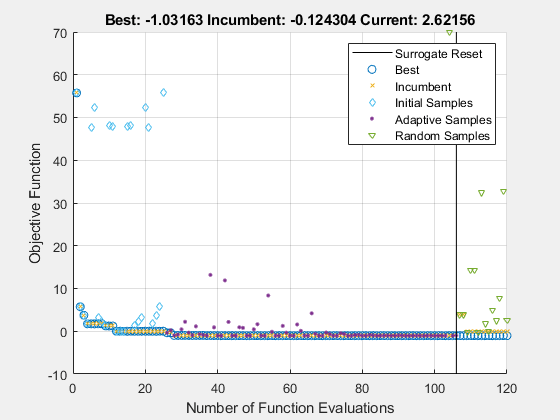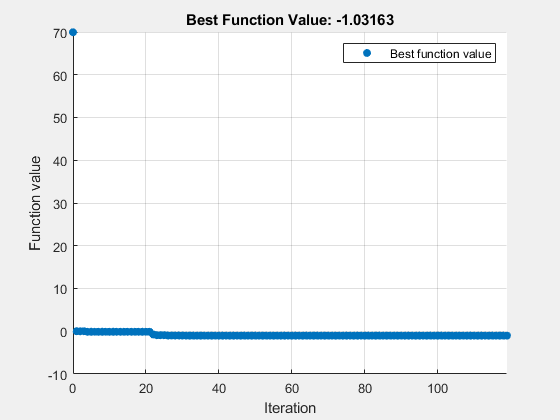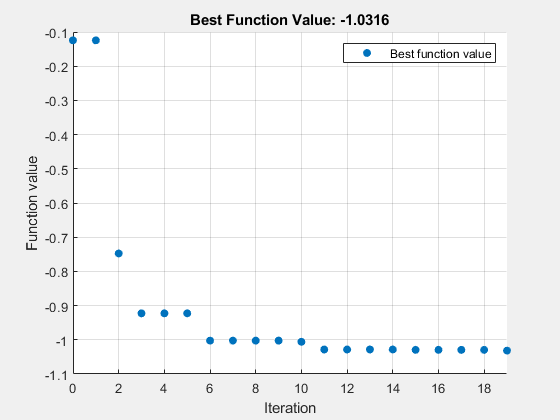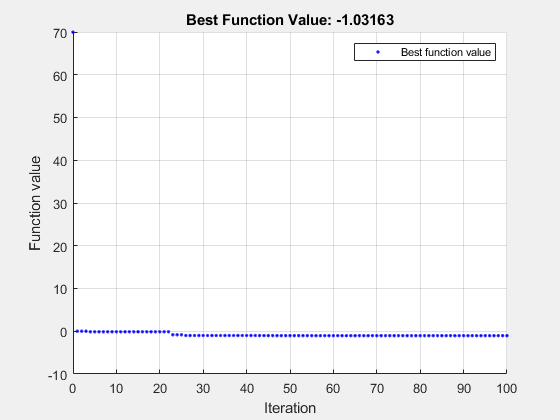surrogateopt
Surrogate optimization for global minimization of time-consuming objective functions
Syntax
Description
surrogateopt is a global solver for time-consuming
objective functions.
surrogateopt attempts to solve problems of the form
The solver searches for the global minimum of a real-valued objective function in
multiple dimensions, subject to bounds, optional linear constraints, optional integer
constraints, and optional nonlinear inequality constraints.
surrogateopt is best suited to objective functions that take a
long time to evaluate. The objective function can be nonsmooth. The solver requires
finite bounds on all variables. The solver can optionally maintain a checkpoint file to
enable recovery from crashes or partial execution, or optimization continuation after
meeting a stopping condition. The objective function
f(x) can be empty ([]), in
which case surrogateopt attempts to find a point satisfying all the
constraints.
x = surrogateopt(objconstr,lb,ub)objconstr(x) in the region
lb <= x <= ub. If objconstr(x)
returns a structure, then surrogateopt searches for a
minimum of objconstr(x).Fval, subject to
objconstr(x).Ineq <= 0.
Note
Passing Extra Parameters explains how to pass extra parameters to the objective function, if necessary.
x = surrogateopt(checkpointFile)
x = surrogateopt(checkpointFile,opts)checkpointFile with those in
opts. See Checkpoint File.
Examples
Input Arguments
Output Arguments
Algorithms
surrogateopt repeatedly performs these steps:
Create a set of trial points by sampling
MinSurrogatePointsrandom points within the bounds, and evaluate the objective function at the trial points.Create a surrogate model of the objective function by interpolating a radial basis function through all of the random trial points.
Create a merit function that gives some weight to the surrogate and some weight to the distance from the trial points. Locate a small value of the merit function by randomly sampling the merit function in a region around the incumbent point (best point found since the last surrogate reset). Use this point, called the adaptive point, as a new trial point.
Evaluate the objective at the adaptive point, and update the surrogate based on this point and its value. Count a "success" if the objective function value is sufficiently lower than the previous best (lowest) value observed, and count a "failure" otherwise.
Update the dispersion of the sample distribution upwards if three successes occur before
max(nvar,5)failures, wherenvaris the number of dimensions. Update the dispersion downwards ifmax(nvar,5)failures occur before three successes.Continue from step 3 until all trial points are within
MinSampleDistanceof the evaluated points. At that time, reset the surrogate by discarding all adaptive points from the surrogate, reset the scale, and go back to step 1 to createMinSurrogatePointsnew random trial points for evaluation.
For details, see Surrogate Optimization Algorithm.
Alternative Functionality
App
The Optimize Live Editor task provides a visual interface for surrogateopt.










